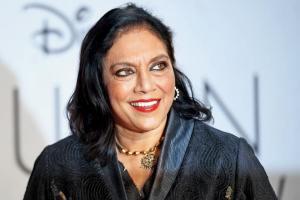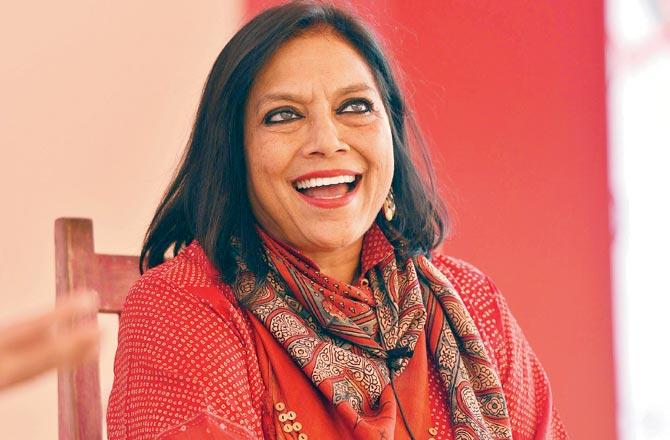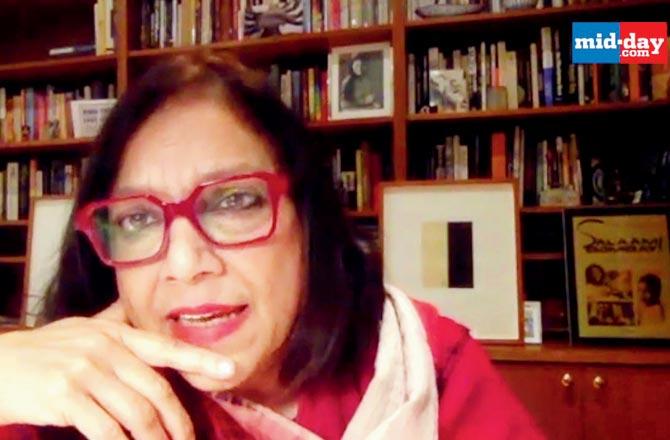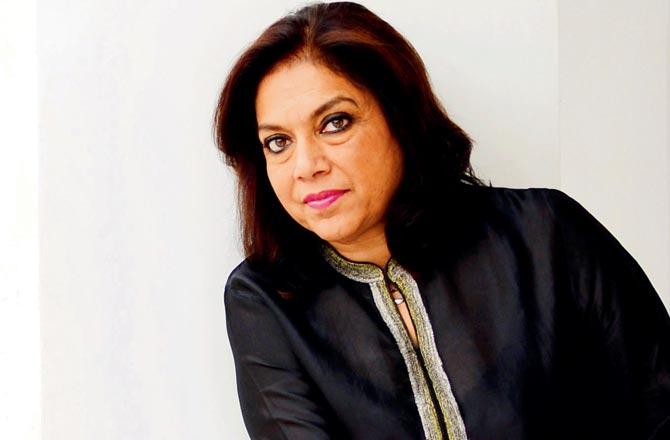From matar paneer to the movies, that sweet taste of Indian-American success from another age

Mira Nair
Mira Nair's journey as an Odisha-born/bred filmmaker in America will seem greater to you, if you consider the first thing she did, landing up as an under-grad student at Harvard in the mid '70s. She went over to her course-mate from Bombay, Sooni Taraporevala, desperately to check on who the other Indians around were.
There were only two — studying film. One of them, a gentleman named Anand Mahindra; the industrialist, whose surname carries the massive fleet of automobiles on Indian roads. "Anand was a really talented filmmaker. He's still an artist in his soul. I'll never forget the wonderful thesis-film he made, following a holy man up a mountain," Mira remembers.
ADVERTISEMENT
Screenwriter Sooni and Mira of course became great friends and colleagues thereafter — collaborating on notable productions like Salaam Bombay (1988), Mississippi Masala (1991), and The Namesake (2006). Anand was the "big brother, who'd encourage everyone to move back to India [once done with studies]." As he did, taking over his family empire.

Mira Nair. Pic/Getty Images
Speaking of famous associations from unrelated fields, a picture that once got widely circulated online was of Mira as Cleopatra and Shashi Tharoor as Mark Antony, in an inter-college Shakespearean production from the '70s. Mira was a student at Delhi University's Miranda House then; Shashi Tharoor, the undisputed star of St Stephen's College.
She's been asked about this picture on occasion during interviews. And I gauge from her responses before — it doesn't seem like she liked the college-kid Shashi Tharoor much! Did he throw big words at her? "Oh no, I just didn't like kissing him [in the play]. Back then, you know how it was — even if you got slightly physically close to someone, people would start cat-calling. It was ridiculous."
As for the Tharoorosaurus bit, "Well, we used to tease Shashi [who hadn't lived or been abroad yet] about where he had got that accent from. We used to say that his mother flew over England, when she was pregnant, and you know, wahaan se thoda atmosphere aa gaya! But he's always been a sport. He used to take it well!"

Entertainment editor Mayank Shekhar connects with the filmmaker over a video call
Which instantly reminds you of Vivek Gomber's character Arun Mehra from Mira's A Suitable Boy, who has similarly never set foot in England, but throws a thick British twang, chiefly to denote class: "Arun Mehra, of course, is [straight] from Vikram Seth's novel [of the same name]." On which the six-part series is based.
In fact the language/diction has been a pet peeve for a lot of people who have dissed the show. In her defense, Mira says, "I feel like we were very nuanced with the language [back then] — trying to be 'angrez', and we were taught to be so. But it is a world that people literally don't know now. They don't hear that world."
To be fair, you do hear that over-intonated, cleanly clipped British-English in old clips, especially of Indian statesmen or women from the time — say, Nehru, or Sarojini Naidu, whose black-and-white video pops up quite often on social media feeds.

The filmmaker joins the virtual edition of Sit with Hitlist from New York
"I don't get that [dialogue/language] comment from people of my mother's generation. Because that was the world familiar to them. I tempered a fair amount of dialogue that I could, during the making of A Suitable Boy — primarily, getting 20 per cent of it back into Urdu/Hindustani and Awadhi. Which wasn't the case before.
"They didn't even think of it. Anyway, so I know that it is new and different to the ear. But I stand by it. Of course, it was from the get-go written by someone else [Andrew Davies]. It could be different. But the book is what we largely followed."
For its setting (early '50s), and set-up (BBC production, streaming on Netflix), Mira has in jest described A Suitable Boy as 'The Crown in brown, within a fraction of the budget!' It is by no means her most loved work, even while rants and raves are subjective by nature. One wonders if, after over 40 years of being an active filmmaker, she cares so much for all that's written about her latest film, or debut series, as in this case?

Mira Nair
"That I am always creatively absorbed in another world provides a protection. So I am not waiting to hear your words; what's the point? And social media is a weirdly interesting space, where I just kinda get a vibe, than actually read a full review. Especially if there is something nasty in the headline," she laughs, flipping her fingers, as if quickly turning pages!
Taking away nothing from the fact that Mira remains still one of the most critically acclaimed filmmakers — for a majority of her filmography. A creative slump/dissatisfaction, if one may call it that, is something she attributes only through self-introspection. Which is how she felt after Kama Sutra (1996): "I wanted to burn every print that existed of that film!" It's not something you'll hear many directors publicly admit, even in hindsight.
As she puts it, "It was also dovetailed with me moving to Cape Town with my husband [Mahmood Mamdani], who was heading the African Studies department at the university. Our son [Zohran] was six and I didn't want to leave him. It was a dove tailing of all those things. I didn't quite know how to work it. We made this film in two months, My Own Country [1998], which Sooni and I wrote after. That was good. I have to keep doing/making things. It was in that wandering that I found myself making a [documentary] film, Laughing Club of India [2001], in my state of malaise. What happened with the shooting of that film in the rain, using old Hindi movie songs? On its own, it became the seed for what became the style of Monsoon Wedding [2001]. That's what I share with people — to be fallow is also important."
Mira is formally trained in cinema verite — art/technique, mostly associated with documentary filmmaking, intended to convey realism. Well before Reese Witherspoon in Mira's costume/period piece Vanity Fair (2004); even before Denzel Washington, a top-draw Hollywood star, who said yes to her mixed-race romance, Mississippi Masala (1991) — struck by the Oscar-nominated Salaam Bombay (1988) — the main muse for Mira's realistic lens was in fact the city of Bombay itself.
Which is where I'm speaking to her from, and where Laughing Club of India is set (in Malabar Hill, to be more precise). So are her two early documentaries: Children of a Desired Sex (1987), on gender-determination foetus tests. And India Cabaret (1985), following lives of two Bombay strip-club dancers, before dance-bars became a thing (and thereafter became illegal). And anybody had thought of Maximum City, or Slumdog Millionaire!
I watched India Cabaret recently (on YouTube). And the warm yet brutal gaze still holds. As with Salaam Bombay, that it subsequently inspired: "It was not a pretty Bombay for sure — pigs careening in the mud; cruelty and violence over how men treated women…. In that type of filmmaking, you don't take holidays. It is about what is happening around you. I remember going to see Shekhar Kapur, who is an old friend, but I almost had no language to understand his Juhu life — after living the life I was, back in 'Antophi' (Antop Hill)! Most days, I would just go to a beautiful handloom shop called Kasab, which is still there on Napean Sea Road, and sit there for hours [for mental peace].
Watch the interview with Mira Nair below:
"Now they can call me a New York-based filmmaker in Bombay, but the fact is that not many saw Salaam Bombay, right under their noses. It was a life around us. When you live in it all the time, you can't see it well — having numbed yourself to it."
This seamless transition from documentary filmmaking to fiction — something that writers of non-fiction find harder to be equally adept at — Mira admits, has helped define her work. And you can still sense strong stamps of it, even in later movies like Queen of Katwe (2016; set in a slum in Kampala, Uganda), or the otherwise 'unfilmable' conversation she turned into the movie version of Mohsin Hamid's The Reluctant Fundamentalist (2012).
"Cinema of truth [cinema verite] sounds a little pretentious. It is very real, in the sense that you don't script everything. You just have to be humble enough to enter the world. Just be there. Of course your presence is shaping [the moment] to some extent. But it is also about being an observer to the situation, and eliciting things from [actors] — as they feel them, rather than you telling them what to say."
What this has also led to since her celebrated debut feature is — film after film, an established practice of casting 'real' people, as it were, or non-professional actors, alongside trained actors/stars, in the same frame. And watching this unique alchemy come to life on screen.
For instance, Mira discovered Sarita Choudhury, who played Denzel Washington's love interest in Mississippi Masala, biking on a street in Cambridge once. She found Tillotama Shome (Alice in Monsoon Wedding) in the corridors of Delhi's Lady Shri Ram College. Even better, she picked up Kamini Khanna for a typically Delhi-Punjabi Shashi Aunty in the same film — spotting her on the walking track of a South Delhi park. Does she think everyone is essentially an actor then?
"Not at all! It's about several things, but mostly instinct. I can tell immediately if the camera will love you or not. Or sometimes it doesn't matter if the camera won't love you, but can I use that in a way? Like [Pedro] Almodovar and his ladies are fantastic. And they so destroy the notion of what's beautiful before a camera. But the roles need that. So it depends on the role, of course."
While casting for Monsoon Wedding, she recalls, a newbie Vijay Raaz's face had caught her eye: "He'd walked in from the train station to Uma's [Da Cunha's] house in Churchgate. I don't know how I even remembered his name. Paresh Rawal, whom I admired a lot, had approached me for PK Dube's part. We had a workshop in Delhi, which Paresh couldn't join. So then I had to take Tillotama [Alice] back to Bombay to rehearse with Paresh [Dube].
"Naseer bhai [Naseeruddin Shah] had given us space above his flat for rehearsal. The door opened, and my eyes fell out. Paresh had gained 30 to 40 pounds. He looked like Alice's father, and this was supposed to be a love-story with him as a tent-walla! He said, 'I'll just lose [weight].'
"But we were shooting in literally four days! I just thought of the bald man with long ears and the widest mouth in the world, Vijay Raaz, and called him. I had not auditioned him, but I loved his look." The role expanded as Raaz came on board, killing it along the way. (This conversation between mid-day and Nair took place a day before Raaz was summarily arrested and subsequently bailed over a molestation charge on a movie set.)
He's had a solid career since. Several Indian actors in the Bombay film industry similarly owe their first frame on the big screen to Mira. Right from Nana Patekar and Irrfan in Salaam Bombay. Late Irrfan, she always felt, was cut from a different cloth from Bombay's leading men in the '80s and '90s. He delivered, arguably, his finest work with Mira in The Namesake (2006).
Or Randeep Hooda and Ram Kapoor, for that matter. They were debutants in Monsoon Wedding; bona fide stars now. Why, even Kamini Khanna! She's played multiple versions of Shashi Aunty in every other Bollywood movie. This contribution to the Bombay film industry in particular, I suspect, isn't acknowledged enough about the New York and Kampala-based filmmaker.
Even more than a keen head-hunter, Mira is an all-encompassing aesthete, wholly invested in cinematography, literature, production design, colours, costumes, the craft of moulding actors/characters… You can dive deep into her 'independent filmmaking' process on an expensive app called Masterclass.
A trait that unites Mira still with the time-honoured tradition of mainstream Indian filmmakers is her exquisite ear for desi poetry and music — whether that be L Subramaniam's musical interludes in Salaam Bombay, or the Monsoon Wedding soundtrack, that melodiously travels from Anu Malik to Farida Khanum. As do the poetry of Daagh, Mir and Ghalib set to ghazals in A Suitable Boy, or the sitar maestro Shujaat Khan showing up on the small screen.
The song playing in my head all through, talking to Mira (and while writing this excerpt) is the haunting Mehfil barkhaast hui by Kavita Seth in A Suitable Boy. Similarly, Susheela Raman's ear-worm version of Mukesh's Yeh mere deewanapan hai had invaded my brain for a full year after The Namesake: "It plays on the suhaag raat, which isn't like any another, because these are Diaspora kids. So there is jazz and blues, with echoes of their roots! They have seen Bollywood stuff and simply want to be stars on their honeymoon night," Mira reasons, before humming the song delightfully herself.
Surprisingly Susheela would simply not sing that track, when she once performed in Bombay, despite repeatedly loud requests from the pit right under the stage. Mira says that could be "because she must have been shy, to sing it in India, in that [British twang]! Even my husband, who is older and knows the real song, says, 'Yeh kya hai?' He can't take it!"
Given the résumé and musical references seeped into her work, besides an army of previous recruits from among top Bombay actors, I'm almost amazed that in all these years, Bollywood folk haven't ever attempted to co-opt Mira with a grand scheme/project?
"I am not looking for that either. But I have really lovely friendships. Yash Johar and I were very close. He was the production manager on one of my films, Buddha, with Warner Brothers, in 1990-91. We travelled the whole country location-scouting. I really respect Aditya Chopra's mind. I had taken him on an idea — not for me to do, but for us to work together on. But, no, I don't think so. I think they think correctly — that I just make my own movies!"
On social networks, Mira goes by the rather odd handle, Pagli: "Don't forget the 'Ji'! Pagli is my nickname from childhood. I did weird things as a kid; still do. My son made me get on social media, when we were opening The Reluctant Fundamentalist. He asked, what's the name, ma? I didn't want my name on it. I thought I'd get hounded beyond belief. So I just said Pagli, yaar. And because people called me ji-vi and all that, usko bhi laga diya, Pagliji — an honoured mad person."
That we can see in person in India, when she brings down Monsoon Wedding, as a stage musical, once pandemic ends, and hell freezes over. A film that would've brought Pagliji back to Bombay — her early muse, and that too with Johnny Depp —was the adaptation of Gregory David Roberts' Shantaram.
Regrets — that the film fell through? "I only regretted that I gave one-and-a-half years of my life to it. And we really had a good thing going. Not, otherwise. They were starting it again, and I was not interested!"
Mira also famously let go of directing the fourth Harry Potter film, for the sake of The Namesake. She declined The Devil Wears Prada, going by the same measure of what interests her — and what she can do, better than similar directors on hire.
"I am very nihilistic like that, I suppose. I just turned down something also very huge few days ago. That's when I fell down into a khadda [a ditch on the street]," she says from her Manhattan apartment, nursing a shoulder pain.
Exuding power, all right, in an industry that when she entered it — doing theatre in New York during day, waiting tables at night — there were barely any coloured people around, let alone desis, or women. It's a world very far away from the one with M Night Shyamalans and Mindy Kalings that we know.
Mira first got on the road, splitting rent for an editing suite at a basement collective for offbeat artistes in New York. This is after she had shot Salaam Bombay. Which she knew the West had no similar reference point for.
Spike Lee, same age, also editing his film, would pay the other half of the rent! "I also used to work at a restaurant called Indian Oven, when they really didn't know how to spell India. I'd explain cottage cheese balls fried in gravy mix of peas — for a 'matar paneer'." They get her now.
*Keep scrolling to read more news*
Catch up on all the latest entertainment news and gossip here. Also, download the new mid-day Android and iOS apps.
Mid-Day is now on Telegram. Click here to join our channel (@middayinfomedialtd) and stay updated with the latest news
 Subscribe today by clicking the link and stay updated with the latest news!" Click here!
Subscribe today by clicking the link and stay updated with the latest news!" Click here!







